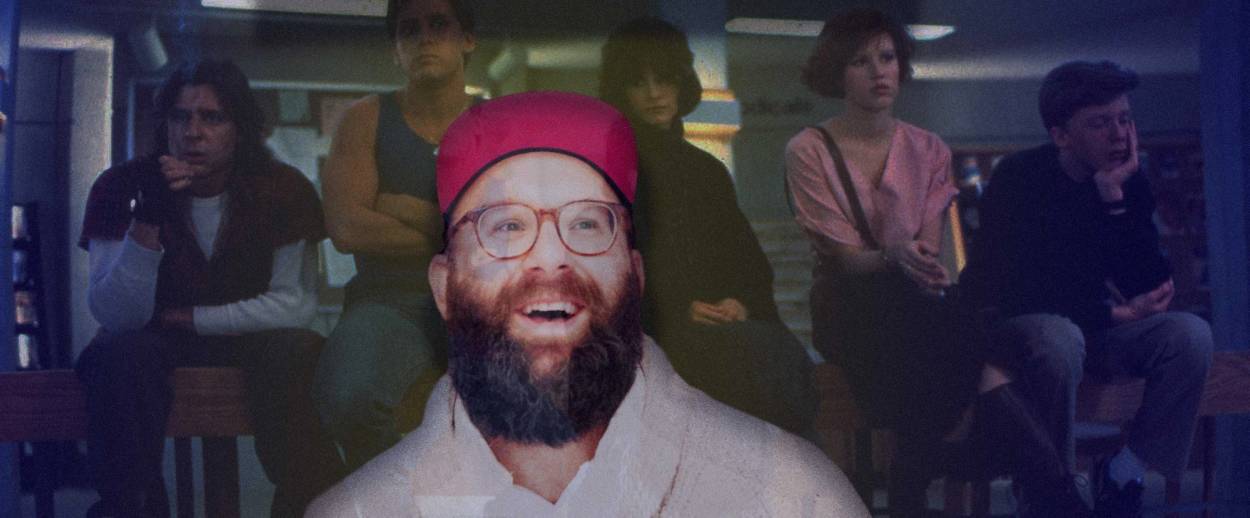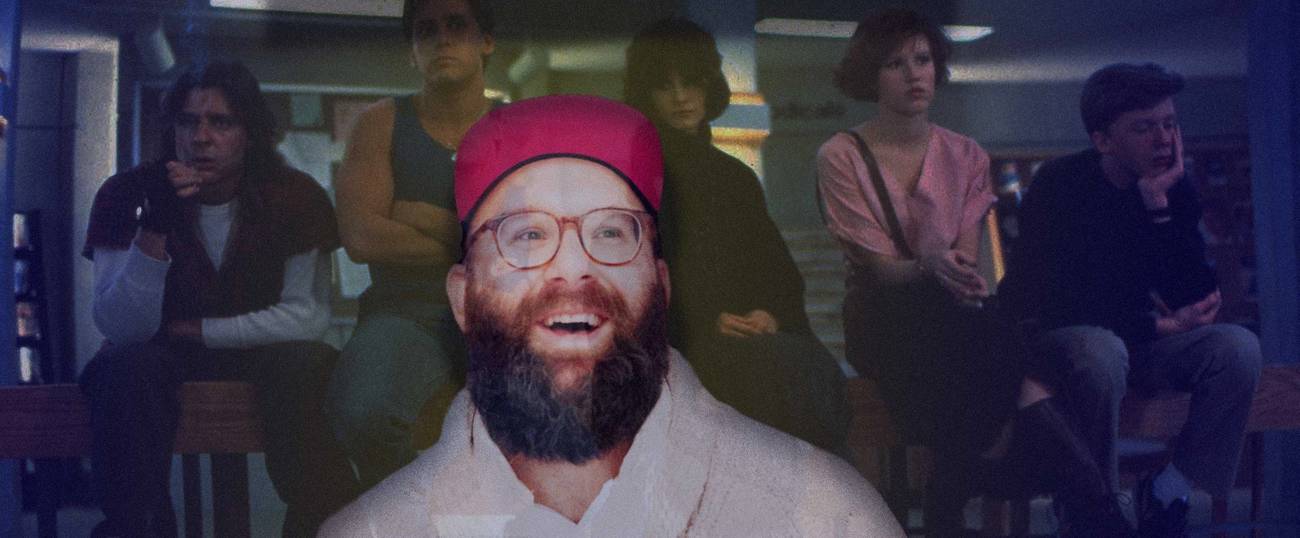John Hughes for the Holidays
Jason Diamond’s wry memoir of 1980s Chicago (and 2010s Brooklyn) finds life landmarks in the awkward, lonely malcontents of The Breakfast Club and Planes, Trains and Automobiles




What happens after the credits? Do Rick and Louie remain friends? Does Sam keep playing songs in the Casablanca bar after the Germans are gone? Do Matt Damon and Ben Affleck’s characters ever speak again? Do the Deltas or the Goonies or the Cutters ever get together for a reunion? Do the soldiers who shared a foxhole stay close once they are back home, as we hope they do, or do they forget about each other and move on? Do John Bender and Molly Ringwald’s characters make it? These questions seem to have haunted Jason Diamond (a Tablet contributor) since the first time he saw Sixteen Candles, and they become a sort of refrain in his funny, eye-opening new memoir Searching for John Hughes.
Diamond, now a 30-something sports editor at Rolling Stone and founder of the culture site Vol. 1 Brooklyn, spent his childhood bouncing between divorced parents, schools, sofas, doss-houses, diners, and countless psychiatrists’ offices, in seemingly every neighborhood on Chicago’s North Shore. Only later would he realize these same locations were stitched together by director John Hughes into an imaginary universe where his ’80s-landmark films Sixteen Candles, Home Alone, Ferris Bueller’s Day Off, and The Breakfast Club would all be filmed. (Hughes named this town Shermer, Illinois.) Though the films have their melodramas, Diamond’s time in these idyllic Chicago suburbs is fraught with abuse, divorce, neglect, and homelessness. To make sense of his own troubles, Diamond turns to the familiar geography of Hughes’ films, as both a coping mechanism and a comforting narrative. Can he, too, he wonders, have his own John Hughes storyline that promises more to Chicagoland teens? “I always let the tape run out,” Diamond narrates after reviewing a Hughes VHS, “thinking how I wanted to know more. I’ve always wondered what was next and what came before.”
Diamond’s memoir starts in the Chicago suburbs in the 1990s, but continues through his young adulthood in a post-Sept. 11 Brooklyn. For nearly a decade he toughs his way through meaningless barista shifts and low-level office jobs, struggling to carve out a path for himself as a writer—ashamed at times about referring to himself as a writer at all. Throughout this time, as he counts his paychecks in ounces of Jameson, Diamond tries to make sense of the deeply enigmatic charm that John Hughes’ films have over him. At the suggestion of a friend, he eventually decides to write an unauthorized biography of John Hughes.
Like a lot of Brooklyn writers, Diamond never finishes his biography. Instead, the search for John Hughes becomes Searching for John Hughes: the story of Diamond’s own years spent quibbling with his past and his hopes of becoming a writer. Diamond routinely squanders opportunities to meet Hughes and members of the Brat Pack. He blunders through publishing-industry meet-and-greets, and loses his agent before even getting signed. He takes on debt to buy Moleskine notebooks. But Diamond is not Ferris Bueller, the happy-go-lucky hero. He is Bueller’s friend Cameron Frye, railing against his upbringing. He seems happiest when his teenage self can sit in front of Lake Michigan stoned out of his mind, able to put his life on hold just long enough to imagine himself in a Hughes storyline where, as Diamond writes, “everything would turn out just right.” Even for delinquents or would-be runaways or scorned suitors.
Later in the book Diamond describes his return to Chicago and the months spent driving through these familiar streets, using them once again as a way to forget that the credits are over and that real life is calling.
The only touchstone in this life of constant turmoil is John Hughes. Every Thanksgiving, with nowhere else to go, Diamond sits down in his New York apartment with a turkey sandwich and watches Planes, Trains, and Automobiles—the story of a traveling salesman, Del Griffith (played by John Candy), who gloms onto Steve Martin and whom we later learn has nowhere to go for Thanksgiving dinner.
Diamond finds that the real world pushes back against the logic of the Hughes universe. There is no happily ever after: “Would [Steve Martin] invite Del into their house so he’d have some sort of family or support system?” Diamond wonders of John Candy’s fate after being invited in by Martin’s family. “I felt as if having Del under their roof would get old pretty soon … and sloppy but lovable Del would probably begin annoying them by December 1st.”
Diamond meditates on his own solitude in this universal nightmare scenario of finding that we have become John Candy and are totally alone on Thanksgiving. But this bleak holiday scene is narrated with such charm that it begins to feel cozy again. Searching for John Hughes is earmarked with these little rituals: the anti-Thanksgivings, long drives around the Chicago suburbs, nightly trips to the same New York bars. And so even though Diamond finds himself in situations that are usually only bearable to witness when tempered by doses of John Candy’s comedy, these refrains in his life allow the writer to tell a warmer, far more intimate story that doesn’t feel all that heartbreaking.
Diamond goes places that nice Jewish boy from a wealthy Chicago family has no place being: uninsured in New York, homeless in Chicago at 16 when his mother moves to South Carolina, quietly suffering through a bruised kidney from his father’s regular beatings, trying to stay awake in 24-hour diners when he has no place else to go.
His Chicagoland universe is painstakingly brought to life through an acute, analytical memory. One day after being kicked out of summer camp for causing trouble, Diamond is picked up by his father but quickly thrown out of the car and told to walk home alone. Diamond remembers the green shirt he was wearing, and how strangely beautiful his North Shore homeland looked during that late afternoon. Later, during his teenage years, Diamond takes the blame for impregnating the daughter of a family who had given him shelter. Along with cataloging every uncomfortable, disappointed stare—as though his teenage self were trying to store these memories away in order to relive them later, hoping they might hurt—Diamond also remembers slowly coiling the frayed corduroy on his pants around his finger as he is interrogated by the girl’s father. Each of these snapshots, along with the encyclopedic knowledge of Hughes’ films and the occasional glimpse into Chicago history, gives us a living portrait not only of Diamond’s mind at various stages of his life, but of the entire world that existed in the townships and neighborhoods around Chicago.
Diamond understands that we don’t reflect on our lives by looking back at a clean narrative timeline. Instead, we see a scattered hodgepodge of moments that we often try to make sense of by using landmarks. This album got us through that breakup, this book was reread every fall during college. Searching for John Hughes tells the story of a life whose landmarks were spread out across the Chicago suburbs and were collected and consecrated by John Hughes. This makes Hughes, in a neat funhouse trick, Jason Diamond’s true biographer.
Can there be life after credits? Perhaps not. But without realizing it, Diamond’s narrator behaves like the most resilient of Hughes’ characters. He finds new jobs each time he is fired, reconciles with old friends, forgives those who do not even seek it, and even manages to take defeating moments in stride, deflecting them all with a coy, wry sense of irony that allows humor to nestle its way out of long stream-of-consciousness sentences. Things always seem to turn out just right. Somehow Diamond always comes up with the exact change for a bodega sandwich and a drink, and that alone may be the best John Hughes ending any of us can hope for.
***
Like this article? Sign up for our Daily Digest to get Tablet Magazine’s new content in your inbox each morning.
Alexander Aciman is a writer living in New York. His work has appeared in, among other publications, The New York Times, Vox, The Wall Street Journal, and The New Republic.